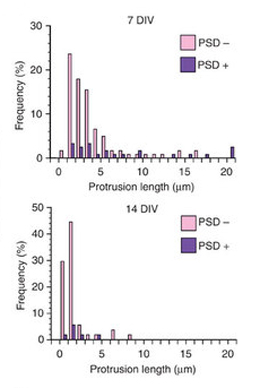Research Abstract
発達中の介在ニューロンの樹状突起でLIS1に依存して起こる、興奮性シナプスの逆行性の移動
LIS1-dependent retrograde translocation of excitatory synapses in developing interneuron dendrites
2012年3月6日 Nature Communications 3 : 722 doi: 10.1038/ncomms1736

神経細胞同士のつながりが正しく形成されるには、樹状突起の伸長と協調しながらシナプスの再配置が起こらなくてはならない。シナプス結合が形成された後に、結合部は安定になり、さらに樹状突起が伸長するための固定的な足場となる。しかし、シナプスの適正な配置を誘導するために樹状突起に沿ってシナプスが活発に移動する可能性については、まだ完全には解明されていない。今回我々は、GABA陽性の介在ニューロンの未成熟な樹状突起からさらに細長い突起が伸び出し、これが誘導経路となって、元の樹状突起のほうへとシナプスの逆行性移動が起こることを明らかにした。この移動過程は微小管を必要とし、またダイニンを介した移動の重要な調節因子であるLIS1の活性に依存している。この逆行性移動を抑制すると、介在ニューロンの樹状突起上のシナプスの配置パターンが乱れてしまう。これらの知見を総合すると、微小管に依存した能動的なシナプス移動機構が存在し、樹状突起上でシナプスを適正に配置するのを助けていることが示唆される。
- 東京大学大学院医学系研究科 神経細胞生物学分野
- 東京医科歯科大学 大学院医歯学総合研究科 細胞生物学分野
- 埼玉大学 総合研究機構 脳科学融合研究センター
- カリフォルニア大学サンフランシスコ校(米国)
- 群馬大学大学院医学系研究科 遺伝発達行動学分野
Synaptic remodelling coordinated with dendritic growth is essential for proper development of neural connections. After establishment of synaptic contacts, synaptic junctions are thought to become stationary and provide fixed anchoring points for further dendritic growth. However, the possibility of active translocation of synapses along dendritic protrusions, to guide the proper arrangement of synaptic distribution, has not yet been fully investigated. Here we show that immature dendrites of γ-aminobutyric acid-positive interneurons form long protrusions and that these protrusions serve as conduits for retrograde translocation of synaptic contacts to the parental dendrites. This translocation process is dependent on microtubules and the activity of LIS1, an essential regulator of dynein-mediated motility. Suppression of this retrograde translocation results in disorganized synaptic patterns on interneuron dendrites. Taken together, these findings suggest the existence of an active microtubule-dependent mechanism for synaptic translocation that helps in the establishment of proper synaptic distribution on dendrites.

